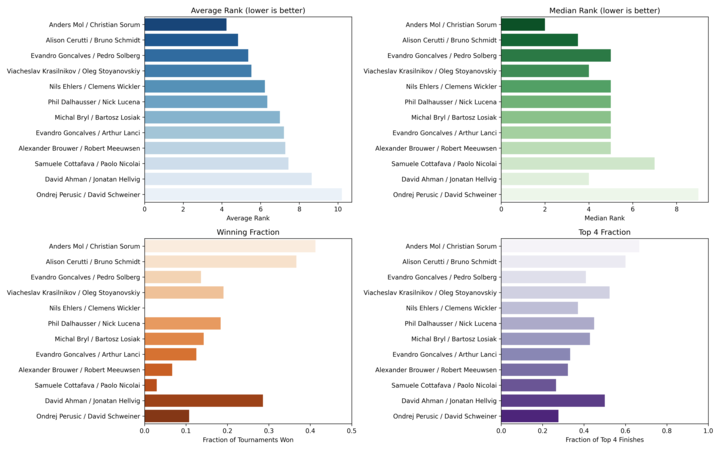I’m an enthusiastic hobby beach volleyball player. And as such, I know how nuances can decide whether a team wins or loses and—more broadly—how tight matches, especially on the pro level, can be.
Irrespective of that, two teams have dominated the last couple of years and whenever they enter a tournament it feels like they always reach the semifinals. Those two are Anders Mol / Christian Sørum (NOR) and David Åhman / Jonatan Hellvig (SWE).
But feelings are one thing. With data at hand (extracted from bvbinfo.com), we can test whether this perceived dominance is actually true. To do this, I scraped the ranks and match data (including set results) of all FIVB tournaments from 2015–2024 and threw them into the MOSTLY AI Assistant. Here’s what I found.
Who Are the Top Teams?
Asking the Assistant for the top teams I got this list sorted by average rank across all tournaments:

Unsurprisingly, Mol/Sørum are at the top of the list with 26 wins (41%) and 40 podiums (63%) out of 63 tournaments.
But where are Åhman/Hellvig? To get a fuller picture, I asked the Assistant to add them as well as Perusic/Schweiner. They are the top Czech team and the World Champions of 2023. They frequently appear in later stages of tournaments - just not as frequently as the two Scandinavian teams.


What the Rankings Reveal
Åhman/Hellvig: Strong win count (12) and a low median rank (4), but their results include a longer tail of lower finishes.
Perusic/Schweiner: Capable of brilliance, but their ranking distribution stretches further into weaker placements.
The violin plots show that the very best teams live in a “narrow band” of high results. Mol/Sørum’s distribution is squeezed tight to top results (=the bottom of the graph) - 75% of the time they finish at least 5th. Perusic/Schweiner, on the other hand, carry a heavier tail of early exits.
How Have Teams Evolved Over Time?
Aggregated stats only tell part of the story. To really understand dominance (and development), we need to look at year-by-year development.

Mol/Sørum: They’ve been remarkably stable across all seasons, with world-class averages throughout. Their peak dominance came in 2019 and 2021, winning ~60% of their tournaments. In 2024, they finished top 4 in every tournament they entered.
Åhman/Hellvig: As the younger team, their curve shows a rapid rise. After strong early years (2018–2020), they dipped in 2021 when facing higher-level competition, but then adapted impressively. By 2022–2024, their average and median ranks rivaled or even beat Mol/Sørum’s, though their Top-4 fraction still lags slightly.
Perusic/Schweiner: Their results have improved steadily since 2016, but always a notch below the Scandinavian powerhouses. Their issue is consistency: the fraction of Top-4 placements remains clearly lower.
Performing Under Pressure: The Tiebreak Test
Beach volleyball is as much mental as it is physical. When a match goes to a third set (tiebreak), the ability to stay calm and flip momentum is crucial.
Looking at the third-set win rate per year Mol/Sørum win an incredible 80% of tiebreaks across nearly all years.

Åhman/Hellvig improved strongly in recent seasons, particularly 2023–2024, when their third-set composure rivaled and surpassed Mol/Sørum’s.
Perusic/Schweiner consistently win above 60%, but never quite at the elite level of the others.
Conclusion: Intuition Confirmed
So, was my intuition right? Absolutely.
Mol/Sørum: Still the gold standard for consistency at an incredibly high level.
Åhman/Hellvig: The heirs to the throne, with results now on par or better in the latest seasons.
Perusic/Schweiner: Strong, but their inconsistency keeps them a notch below.
At the highest level of beach volleyball, margins are razor-thin. But when you combine talent, consistency, and mental strength, you get what we see in Mol/Sørum and Åhman/Hellvig: teams that simply belong in semifinals and finals. Hats off to them—and to every team grinding it out in the Beach Volleyball World Tour.
I’m aware that there is much more to analyse and comment on. The dominant performance of Alison/Bruno - the Olympic Champions of 2016 - in the early years of the current time window. The consistent performance of Ehlers/Wickler, the Olympic Silver Medalists of 2024. The fact that FIVB tournaments do not cover European Championships and Olympic Games. etc. So if you are interested in a deeper analysis or how the numbers of your favorite team compares to the ones above, check out this open-access data set and explore it with the MOSTLY AI Assistant.



